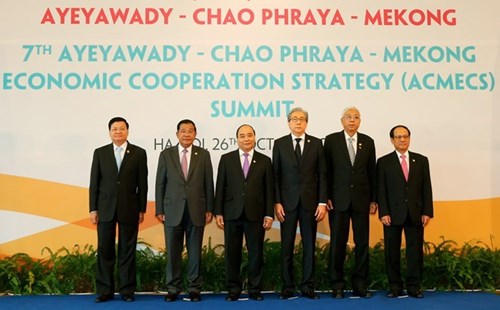As two cooperation mechanisms of the Mekong Sub-region countries, ACMECS and CLMV were born with the aim of bridging development gaps, improving competitiveness, boosting economic growth and the integration of Mekong Sub-region countries in ASEAN and in international arena while supporting the building of a more integrated ASEAN Community.
In November 2003, at the Bagan Summit initiated by Thailand, the ACMECS was established with four members, namely Cambodia, Laos, Myanmar and Thailand. A year later, in November 2004, Vietnam was officially admitted to the ACMECS.
    |
 |
|
Delegates at the event. Source: VNA |
The ACMECS’s inclusive goal is to ensure peace, stability and prosperity and its key target is to promote competitiveness, economic growth along shared borders among countries, boost agriculture and industry development in an effective and sustainable way, open up job opportunities and narrow the development gaps among nations. The ACMECS focuses cooperation in eight fields of trade-investment, agriculture, industry-power, transport, tourism, human resource development, health and environmental protection.
Meanwhile, at the ASEAN-Japan Summit in December 2003 hosted by the Japanese city of Tokyo, senior leaders of Cambodia, Laos, Myanmar and Vietnam (CLMV) agreed to form a high-ranking meeting mechanism among the CLMV.
The establishment of the CLMV is among the efforts to meet objective integration requirement of Mekong Sub-region and ASEAN. However, the biggest barrier for ASEAN integration were the development gaps among ASEAN member countries, especially among the CLMV and ASEAN countries. Therefore, the foundation of the CLMV came from the wish to narrow the development gaps, so as to boost the CLMV’s integration in the common development process of the region.
The CLMV cooperation is an open mechanism which brings into play advantages and available cooperation potentials of the CLMV and calls for support from ASEAN member countries and development partners.
The CLMV cooperation concentrates on six priorities: trade-investment, agriculture, industry, transport, tourism and human resource development.
After 15 years of operation, the ACMECS and CLMV have reaped encouraging results, delivering strengthened economic, trade and investment cooperation among Mekong Sub-region countries, narrowed development gaps in ASEAN and raised an elevated voice for members in regional and international integration processes.
In fact, an active and responsible Vietnam has made important contributions to these two cooperation mechanisms. Vietnam has proactively proposed and carried out a number of initiatives, contributing to building important documents, forming and boosting initiatives, providing development assistance to member countries, including human resource development and infrastructure construction.
In the ACMECS and CLMV cooperation, Vietnam has played a coordinating role in specialized cooperation and implemented various practical activities to reinforce comprehensive cooperation among the five nations.
In the ACMECS, Vietnam has exerted all-out efforts to meet common goals in order to bring into play potentials, boost sustainable development and create bigger attractions to partners both inside and outside ASEAN.
In the CLMV, on the basis of its strength in economic scale, development, renewal and international integration experiences, Vietnam has brought forward initiatives, contributed resources to promote infrastructure connectivity, human resource development, sustainable resource exploitation and the joint development projects of the four countries.
The attendance of Prime Minister Nguyen Xuan Phuc and the Vietnamese delegation in the ACMECS 8 and CLMV 9 demonstrates Vietnam’s high respect for and deep interest in the two cooperation mechanisms, contributing to promoting connectivity among regional countries as well as enhancing the friendship among Vietnam and Thailand, Cambodia, Laos and Myanmar.
The ACMECS 8 and CLMV 9 carry the hopes of Vietnam for success, contributing to consolidating peace, stability, integration and development in the Mekong basin area.
Written by Editorial Board
Translated by Mai Huong